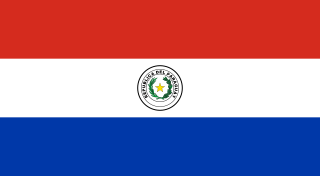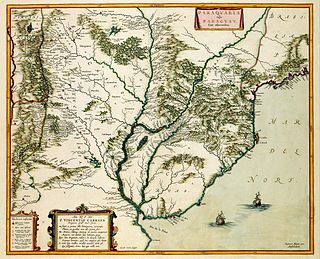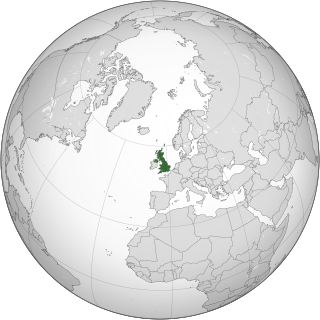
Latin America is a collective region of the Americas where Romance languages—languages derived from Latin—are predominantly spoken. The term was coined in France in the mid-19th century to refer to regions in the Americas that were ruled by the Spanish, Portuguese, and French empires.

Paraguay, officially the Republic of Paraguay, is a landlocked country in South America. It is bordered by Argentina to the south and southwest, Brazil to the east and northeast, and Bolivia to the northwest. It has a population of around 6.1 million, nearly 2.3 million of whom live in the capital and largest city of Asunción, and its surrounding metro area.

The history of Paraguay encompasses thousands of years of human habitation. Both agricultural and nomadic Guaycuruan lived in the region at the time of the Spanish Conquest. It became a relatively neglected part of the Spanish Empire due to its isolation and lack of mineral wealth, nonetheless a small group of Spanish settlers came to reside in the area, increasingly intermarrying with native women to produce a mestizo population. In the 17th and 18th centuries, Jesuit missionaries organized the natives into planned communities known as reducciones, and the experiment gained notable attention in Enlightenment Era Europe.

The economy of Paraguay is a market economy that is highly dependent on agriculture products. In recent years, Paraguay's economy has grown as a result of increased agricultural exports, especially soybeans. Paraguay has the economic advantages of a young population and vast hydroelectric power. Its disadvantages include the few available mineral resources, and political instability. The government welcomes foreign investment.

South America is a continent entirely in the Western Hemisphere and mostly in the Southern Hemisphere, with a considerably smaller portion in the Northern Hemisphere. It can also be described as the southern subregion of the Americas.

Asunción is the capital and the largest city of Paraguay. The city stands on the eastern bank of the Paraguay River, almost at the confluence of this river with the Pilcomayo River. The Paraguay River and the Bay of Asunción in the northwest separate the city from the Occidental Region of Paraguay and from Argentina in the south part of the city. The rest of the city is surrounded by the Central Department.

The German diaspora consists of German people and their descendants who live outside of Germany. The term is used in particular to refer to the aspects of migration of German speakers from Central Europe to different countries around the world. This definition describes the "German" term as a sociolinguistic group as opposed to the national one since the emigrant groups came from different regions with diverse cultural practices and different varieties of German. For instance, the Alsatians and Hessians were often simply called "Germans" once they set foot in their new homelands.

The Paraguayan War, also known as the War of the Triple Alliance, was a South American war that lasted from 1864 to 1870. It was fought between Paraguay and the Triple Alliance of Argentina, the Empire of Brazil, and Uruguay. It was the deadliest and bloodiest inter-state war in Latin American history. Paraguay sustained large casualties, but the approximate numbers are disputed. Paraguay was forced to cede disputed territory to Argentina and Brazil. The war began in late 1864, as a result of a conflict between Paraguay and Brazil caused by the Uruguayan War. Argentina and Uruguay entered the war against Paraguay in 1865, and it then became known as the "War of the Triple Alliance."
This article details the geographical distribution of speakers of the German language, regardless of the legislative status within the countries where it is spoken. In addition to the Germanosphere in Europe, German-speaking minorities are present in many other countries and on all six inhabited continents.
The German minority in Paraguay came into existence with immigration during the industrial age. The "Nueva Germania" colony was founded in Paraguay in 1888; though regarded as a failure, it still exists despite being abandoned by many of its founders in the 1890s. Paraguay was a popular place for German leaders accused of war crimes to retreat after the second World War. There are large communities of German descendants living in the department of Guairá, in a town called, the department of Itapúa, mainly in the Departmental Capital, Encarnación and the German towns of Obligado, Bella Vista and Hohenau. Some recent Brazilian immigrants to Paraguay also have German ancestry (Brasiguayos). Notable Paraguayans of German descent include the former president of Paraguay Alfredo Stroessner.

The Treaty of the Triple Alliance was a treaty that allied the Empire of Brazil, Argentina, and Uruguay against Paraguay. Signed in 1865, after the outbreak of the Paraguayan War, its articles prescribed the allies' actions both during and after the war. The war led to the near-annihilation of Paraguay.
English Argentines are citizens of Argentina or the children of Argentine citizens brought up in Argentina, who can claim ancestry originating in England. The English settlement in Argentina, took place in the period after Argentina's independence from Spain through the 19th century. Unlike many other waves of immigration to Argentina, English immigrants were not usually leaving England because of poverty or persecution, but went to Argentina as industrialists and major landowners.
British Latin Americans are Latin Americans of British ancestry.
The English diaspora consists of English people and their descendants who emigrated from England. The diaspora is concentrated in the English-speaking world in countries such as the United States, Canada, Australia, New Zealand, Scotland, Ireland, Wales, South Africa, India and to a lesser extent, Zimbabwe, Zambia and continental Europe.

Throughout its history, agriculture in Paraguay has been the mainstay of the economy. This trend has continued today and in the late 1980s the agricultural sector generally accounted for 48 percent of the nation's employment, 23 percent of GDP, and 98 percent of export earnings. The sector comprised a strong food and cash crop base, a large livestock subsector including cattle ranching and beef production, and a vibrant timber industry.

The Southern Common Market, commonly known by Spanish abbreviation Mercosur, and Portuguese Mercosul, is a South American trade bloc established by the Treaty of Asunción in 1991 and Protocol of Ouro Preto in 1994. Its full members are Argentina, Brazil, Paraguay and Uruguay. Venezuela is a full member but has been suspended since 1 December 2016. Associate countries are Bolivia, Chile, Colombia, Ecuador, Guyana, Peru, and Suriname.
Foreign direct investment by Great Britain into Argentina was attempted, initially with little success, from the early years after Argentina's independence in the 1820s. However, it grew to large proportions in the second half of the 19th century and remained so up to the Second World War, in association with greater political stability and favourable policies in Argentina. British ownership of large parts of Argentina's industry and railway system, and British control of the financial capital that backed Argentina's growing prosperity at that time, resulted in a strong relationship between the two countries, which is viewed by some as having contained elements of imperialism.

Latin America–United Kingdom relations are the diplomatic, economic and cultural relations between the United Kingdom and the countries of Latin America.
White Paraguayans or European Paraguayans are Paraguayan people whose ancestry lies within the continent of Europe, most notably Spain, Italy and Germany, and to a lesser extent, Ukraine and Poland.











